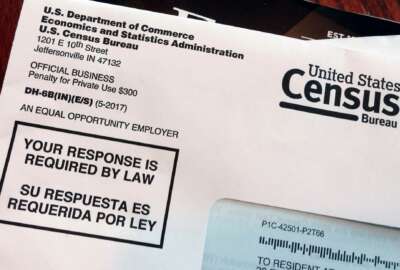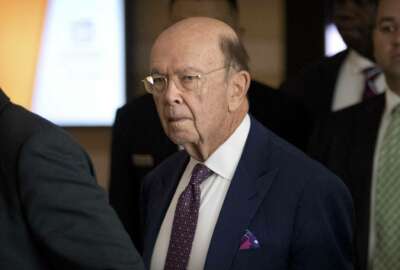
From field test to prime time: How does the Census Bureau scale up its operations?
Before the Census Bureau rolls out its messaging campaign in October, it'll have to pore over reports of what went right in the Providence field test, and what...
Best listening experience is on Chrome, Firefox or Safari. Subscribe to Federal Drive’s daily audio interviews on Apple Podcasts or PodcastOne.
Less than two years out from the 2020 population count, the Census Bureau is wrapping up its one and only dress rehearsal.
For the past few months, the agency has been testing out its new IT systems in Providence County, Rhode Island as part of its push to the 2020 count, the first tech-driven census.
Since June, Census Bureau employees have knocked on doors and follow up with households that have not yet completed their test forms.
The 2020 population count marks the first time that households can respond to the census online at Census.gov or over the phone through an agency hotline.
But before the agency rolls out its messaging campaign in October, it’ll have to pore over reports of what went right in the Providence field test, and what didn’t.
“A good way to look at it is the Census Bureau, for all of this decade, has basically been flying above the clouds at 35,000 feet, doing a lot of important work — largely out of public sight, and somewhat out of sight of Congress — now they are at a point where they have to get ready to come in for the landing,” Terri Ann Lowenthal, a former staff director of the House census oversight subcommittee, and a former adviser on census issues for Obama transition team, said in an interview.
Despite constrained budgets early in the lifecycle of the 2020 count, the Census Bureau has no wiggle room under the deadlines it has to meet under the Constitution.

The agency must begin the population count on April 1, 2020, and deliver the results of the count to President Donald Trump by Dec. 31.
Testifying before the House Oversight and Government Reform Committee in May, acting Census Bureau Director Ron Jarmin estimated 64 percent of field test respondents answered online, more than double the rate of people who mailed back their questionnaire the old-fashioned way.
But Lowenthal said she’s concerned how Census.gov will handle a much larger volume of responses when the nationwide count begins in 2020, much like how HealthCare.gov experienced intermittent outages during its launch in October 2013.
“While things seem to have gone relatively smoothly during the dress rehearsal, one key issue is load capacity,” she said. “The magnitude who will hopefully go online to respond to the census is many-fold beyond what happened with HealthCare.gov, so the Census Bureau really has to make sure that all of its systems can handle a very significant load.”
In addition to providing better service for the public, the Census Bureau looks to drive down costs by allowing households to respond online.
The 2020 count will be the most expensive one on record. In April, the Census Bureau estimated the count would cost $15.6 billion — about 27 percent, or $3.3 billion, more than projected in October 2015.
But while moving the count online reduces the need for the agency to hire enumerators to knock on doors, it also raises new concerns about cybersecurity.
“Technology brings cybersecurity risks, real and perceived. There are concerns about hacking, phishing scams, which are substantially outside of the Census Bureau’s control. There’s public perception about putting personal information online [and] whether these systems are secure, and so the Census Bureau has to really address all of these challenges,” Lowenthal said.
And with the last-minute addition of a citizenship question to the 2020 census form, some experts have raised concerns over whether the question would hurt response rates.
Speaking on a panel at the National Association of Latino Elected and Appointed Officials (NALEO) conference in Phoenix on June 23, acting Census Bureau Director Ron Jarmin sought to assure lawmakers that the population count data would remain confidential.
“I think we need to get out to everybody that participating in the census is safe [and] is secure. Title 13 is a very strict law in terms of what it says the Census Bureau can use this information for: statistical purposes only. We do not provide any of this data to any other government agency,” Jarmin said, citing a provision in the U.S. Code.
The agency also must address the nation’s “digital divide,” and ensure that populations with less access to the internet don’t get underrepresented by the census.
Last year, the Census Bureau reported that only 62 percent of households had “high connectivity,” meaning they had a desktop or laptop computer, a smartphone and broadband internet access.
“Many people think about low-income household as perhaps not having access to the internet. That is certainly the case, [but] also older households where they may have access to broadband, but they may not regularly use the internet or feel comfortable with the internet,” Lowenthal said.
The digital divide also disproportionately affects rural areas. The Census Bureau originally planned to conduct a full-scale field test in the Bluefield-Beckley-Oak Hill region of West Virginia and suburban Washington state, but due to budget shortfalls, it had to scale back to tests to only address canvassing.
Even then, Lowenthal said Census employees in West Virginia reported reception problems.
“They had difficulty with their mobile devices in the rural areas,” she said.

Navigating without a permanent director
As the Census Bureau enters the home stretch of the 2020 count, the agency continues to operate under temporary career leadership.
The last permanent census director, John Thompson, stepped down from his position last summer. Since then, the Trump administration has yet to nominee a new agency head.
“It’s true that identifying, nominating and then confirming a census director has rarely been at the top of the list for any new administration,” Lowenthal said.
The deputy director position, which handles more of the day-to-day operations of the agency, does not require Senate confirmation, but nonetheless has not received a nomination from the president.
Enrique Lamas, a senior career employee of the agency, currently serves as the acting deputy director.
“The acting director and acting deputy director are highly qualified career employees, and are well respected, but it doesn’t take the place of having a nominated a Senate-confirmed Census Director who can speak with more authority to Congress and the American public,” Lowenthal said.
Copyright © 2025 Federal News Network. All rights reserved. This website is not intended for users located within the European Economic Area.
Jory Heckman is a reporter at Federal News Network covering U.S. Postal Service, IRS, big data and technology issues.
Follow @jheckmanWFED
Related Stories




